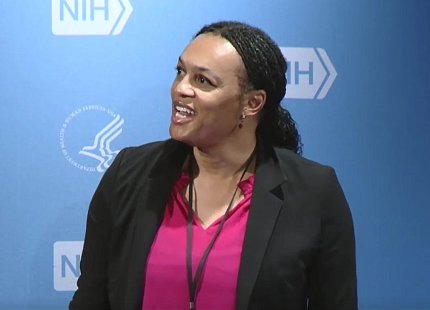Healthy, Authentic Engagement
Proper Use of Pronouns Creates a More Welcoming NIH

NIH is working to ensure that everyone, including the lesbian, gay, bisexual, transgender and queer (LGBTQ+) community, can live authentically without prejudice or discrimination.
Understanding the differences between sex and gender and the proper use of pronouns can help create a welcoming, respectful and inclusive workplace for sexual and gender minorities (SGM), said Dr. Karen Parker, director of NIH’s Sexual and Gender Minority Research Office at a recent Pride Month forum focused on SGM/LGBTQ+ hot topics. The forum was part of the Clinical Center’s DEIA Forums Series.
In 2015, NIH began using the term SGM. These include—but are not limited to—individuals who identify as lesbian, gay, bisexual, asexual, transgender, Two-Spirit, queer and/or intersex.
The terms sex and gender are often used interchangeably, Parker said. While these constructs are related, they are distinct, she pointed out. Sex refers to a set of biological traits in humans and animals. Every person is assigned a sex at birth, which is typically determined via the presence or absence of male or female sex organs.
Gender refers to socially constructed roles, behaviors, activities and/or attributes that a society associates with being a woman, man, girl or boy, as well as relationships with each other. Then there is sexual orientation, which refers to emotional, romantic or sexual attraction.
People use many different terms to describe their gender. A few examples include non-binary (those who don’t subscribe to the concept of solely two gender alternatives—man or woman); nonconforming (individuals who don’t present themselves according to typical gender stereotypes); and transgender (people whose gender identity is different from their sex assigned at birth).

“Someone’s gender identity is something that a person should identify themselves,” Parker noted. “You should not be identifying for them.”
She advised people who are unsure of someone’s pronouns to ask, “What are your pronouns?” One can also gather information about a person’s pronouns through a trusted source.
Allies of the SGM community can share their pronouns in email signatures, on name tags and at the beginning of meetings, suggested Bali White, principal strategist for the SGM portfolio in NIH’s Office of Equity, Diversity and Inclusion. Normalizing pronoun sharing creates a more inclusive workplace for everyone.
However, disclosing one’s personal pronouns is an individual choice, White added. “We don’t want to put pressure on people to identify if they don’t feel comfortable.”
Referring to someone using a pronoun or name that does not correctly reflect their gender identity is known as misgendering or deadnaming. It can be unintentional or intentional. White said calling a person the name they were given at birth instead of their chosen name can be “triggering,” because the previous name “is associated with a time in their life or experiences that they feel like are behind them.”
The best way to handle misgendering someone is to apologize, said Wade Atkins, supervisor of quality assurance and regulatory affairs in the Clinical Center’s department of transfusion medicine (DTM).
The power of “I’m so sorry” goes a long way, he said. “It opens a communication channel that you accept and recognize changing cultural behavior.”
It’s important, however, to not turn an apology into “a conversation about yourself,” added Haley Maness, a senior CC clinical research and safety quality nurse. “That turns the focus on you and puts the onus on the other person to forcibly forgive you or accept what you’re saying.”

Health care providers must sometimes verify a patient’s demographic or identifying data even if that doesn’t align with a patient’s gender identity. DTM’s goal, for example, is to protect the blood supply.
“Sometimes we have to confirm the person in front of us is legally registered,” Atkins said. After confirming a person’s identity, “we do have latitude to drift towards correct pronouns and names.”
In these situations, Maness advised providers to use comforting language to describe the policy and why it’s in place. In all other interactions, “try to be as affirming as you can. Use their correct name in any other instance.”
Creating a more inclusive environment will benefit everyone, Parker concluded.
According to a recent Gallup poll, one in five Gen Z adults identifies as SGM. Fostering a respectful workplace will help attract and retain top scientists and clinical staff.
“If we aren’t taking care of this community, we run the risk of losing top talent,” she concluded.
